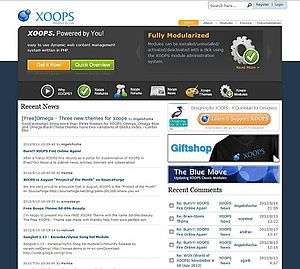XOOPS
XOOPS /ˈzuːps/[2] is a free open-source content management systems (CMS), written in PHP. It uses a modular architecture allowing users to customize, update and theme their websites. XOOPS is released under the terms of the GNU General Public License (GPL) and is free to use, modify and redistribute.
 | |
 | |
| Developer(s) | The XOOPS Project |
|---|---|
| Stable release | |
| Preview release | 2.6.0 alpha 3 (September 18, 2013) [±] |
| Repository | |
| Written in | PHP |
| Type | content management system |
| License | GPL |
| Website | xoops |
Overview
XOOPS is an acronym of "eXtensible Object Oriented Portal System". Though started as a portal system, it later developed into a web application framework. It aims to serve as a web framework for use by small, medium and large sites, through the installation of modules. For example, a small XOOPS installation can be used as a personal weblog or journal, but this can be expanded upon and customized, i.e. users might add the appropriate modules (freeware and commercial) to store content in news, forums, downloads, and others.[3]
Books have been written about XOOPS in five languages.[4]
Awards and recognition
- 2006 Community Choice Awards, first runner-Up status in the SourceForge.net's in the development category
- A 2008 review from Germany's "Chip" magazine gave it 5 stars;[5] a 2008 review in "Adobe Edge" magazine placed it in the Top 3 content management systems[6]
- 2008 China-Japan-Korea Open Source Software Contest Award[7]
- 2008 Top 5 in Packt Publishing's "Best PHP Open Source CMS"[8] and was Top-5 finalist in 2009 Best Overall CMS Award category.[9] Onokazu, a founder of XOOPS and Taiwen Jiang, Development Lead, won the title of "Open Source CMS Most Valued People" at the Packt awards in 2008[10] and 2009[11] respectively.
- 2009 Grand Prize in OSS Challenge in Korea[12]
Key features
- Community
- Because XOOPS is released under the terms of the GNU General Public License (GPL) the growth and development of XOOPS is dependent on the contributions of a worldwide community effort.
- Database
- XOOPS uses a relational database (currently MySQL) to store data required for running a web-based content management system.
- Advanced access control layer
- Administrators have the ability to grant specific groups of users specific access rights to content and features such as edit, delete, upload, add attachments, publish content, and so on.
- Modularized
- Modules can be installed, uninstalled, activated, and deactivated using the module administration system.
- Core features usable by modules
- XOOPS possess a number of core features that can be used by modules like permissions, comments, notifications and blocks features.
- Personalization
- Administrators have the ability to set specific permissions for user access and control of individual elements of their websites.
- User Management
- The ability to search for users by various criteria, send email and private messages to users through a template-based messaging system.
- International language support
- The XOOPS community has official support sites for non-English-speaking users. Additionally XOOPS itself supports multi-byte character sets for languages that use characters not in the Latin alphabet, for example Japanese, Simplified and Traditional Chinese, Korean, etc. The multi-language support is also available on the PDF generation feature provided by the TCPDF library.
- Theme-based skinnable interface
- XOOPS uses themes for page presentation. Both administrators and users can change the look of the entire web site by selecting from available themes.
- Templates
- XOOPS uses the Smarty templating engine which allows many benefits such as easier separation between business logic and presentation logic as well as content caching.
- Built-in LDAP authentication
- Some SEO add-ons
- A number of XOOPS modules contain features to facilitate the indexing of a website in search engines, like metatags, title tags and occasionally some URL rewriting. However, XOOPS does not give its users full control over their URLs. Where URL rewriting is possible, XOOPS often uses redirects that may confuse search engines. In addition, some XOOPS modules create duplicate content by making the same information available on more than one URL while in other cases (especially in case of multilingual sites), several sets of content may be made available through the same URL.
Screenshots
See also
- Content management system
- Free software
- Open source software
References
- "Download the latest XOOPS releases". xoops.org. Retrieved 21 June 2019.
- "All About XOOPS - XOOPS Web Application System". www.xoops.org.
- Spick, Goeff (October 27, 2009). "Latest XOOPS Web CMS Release Bolsters Admin Usability". CMS Wire.
- "XOOPS Books". XOOPS. November 17, 2008.
- "XOOPS gets 5 Stars from Germany's CHIP - News - XOOPS News - XOOPS Web Application System". www.xoops.org.
- "Adobe Edge selects XOOPS as one of Top 3 CMS - News - XOOPS News - XOOPS Web Application System". www.xoops.org.
- "XOOPS China Wins OSSContest Award - XOOPS - XOOPS News - XOOPS Web Application System". www.xoops.org.
- Johnston, Mike (January 24, 2009). "2008 Open Source CMS Award Finalists Announced". CMS Critic.
- Ruby, Bryan (September 22, 2009). "Finalists in Packt's 2009 Open Source CMS Award announced". CMS Report.
- "Packt Publishing - Technology Books, eBooks & Videos". www.packtpub.com.
- "Packt Publishing - Technology Books, eBooks & Videos". www.packtpub.com.
- "XOOPS wins Grand Prize in OSS Challenge in Korea - XOOPS - XOOPS News - XOOPS Web Application System". www.xoops.org.